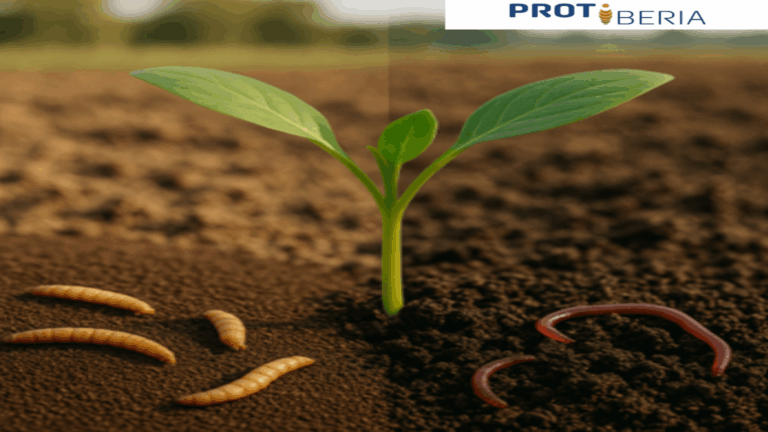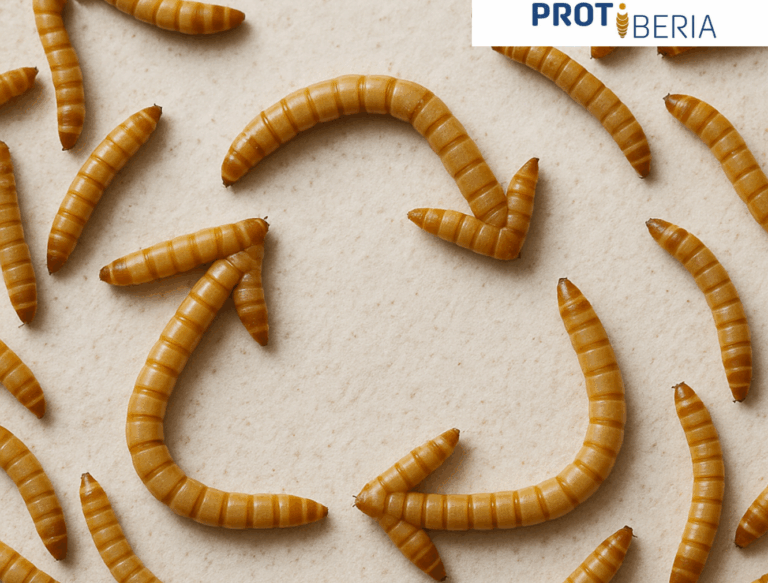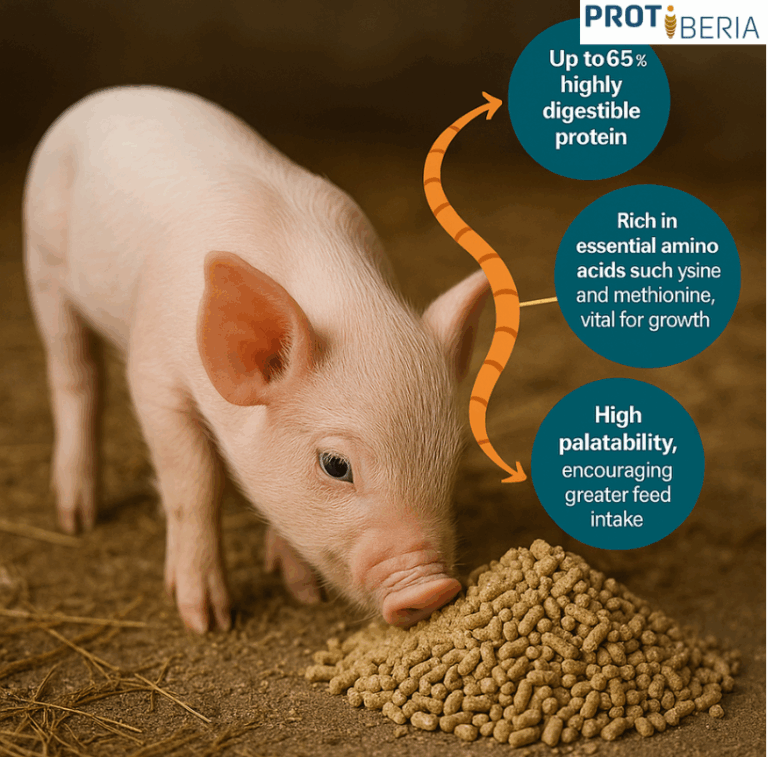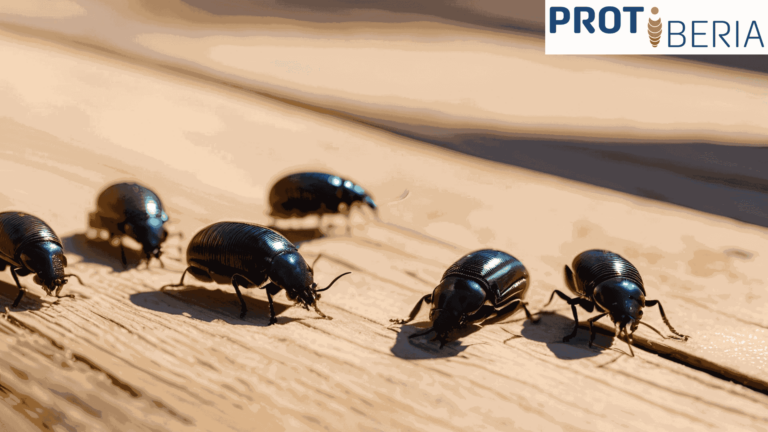| In this article we evaluate two organic fertilisers: Tenebrio molitor frass and earthworm humus. We analyse their composition, benefits and applications to see their usefulness according to the needs of your soil and crop. The key is to understand the differences versus chemical fertilisers and how they can complement each other to improve soil health and agricultural sustainability. |
In the world of organic fertilisers, not all substrates are the same. Tenebrio molitor frass and worm castings share a natural origin, but their properties, composition and applications are very different. Combining the two can make all the difference to the health of your soil and the performance of your crops. The key is to understand what your soil needs: active organic matter? rapidly assimilated nutrients? natural defences against pests?
Let’s take a closer look.
1.Origin and Structure: Two Fertilisers, Two Philosophies
– Frass from Tenebrio molitor: These are the excrements of flour beetle larvae, enriched with chitin, enzymes and natural hormones derived from their diet. Its structure is granular and porous, which improves soil aeration.
– Earthworm humus: The result of the digestion of organic matter by earthworms (such as Eisenia fetida). It is a homogenous, spongy material, rich in humic acids and beneficial micro-organisms.
Why does it matter?
Frass and humus do not compete; they complement each other as allies in soil and plant care. Frass, with its chitin content, acts as a natural biostimulant that strengthens plant defences and enhances plant development, while humus works quietly over the long term, rebuilding soil structure, retaining moisture and storing essential nutrients. Together, they create a fertile, resilient and balanced environment.
If your soil is impoverished, humus and frass will bring it back to life; if you also want to prevent pests and stimulate vigorous growth, frass will be the ideal complement. But don’t be fooled by the dark colour of the soil: it is not always a sign of quality. What really matters is the life that lives in the soil, and that is where frass and humus become a powerful duo.
2. Technical Analysis: Organic Matter, Microbiota and Real Value
According to the characteristics to be evaluated:
Organic matter and microbiota:
o Worm humus contains a high microbial diversity (nitrogen fixing bacteria, mycorrhizal fungi), essential for soils poor in life.
o Frass stands out for its high concentration of specific microbiota (such as Bacillus spp.), which fights pathogens such as Fusarium or Pythium. In addition, its high organic matter content (89%) improves soil structure, increasing the capacity to retain water and nutrients.
Nutrients and efficiency:
o Frass has a higher concentration of rapidly assimilable nitrogen (N) and phosphorus (P), ideal for demanding crops. With around 5(N)-4(P)-3(K). In addition, its high proportion of labile carbon stimulates microbial activity in the soil, promoting the decomposition of organic matter and improving soil fertility by promoting root development, flowering and fruiting, and increasing plant resistance to adverse conditions such as drought and salinity.
o Humus provides potassium (K) and slow-release trace elements, perfect for depleted soils.
Weight and economic value:
o Frass is lighter and drier, which means you don’t pay for water (unlike some commercial humus with high moisture).
o Humus, being denser, can retain moisture better in sandy soils.
3. Chitin vs Humic Acids: Two supercompounds with similar functions
Chitin (frass):
o Stimulates natural plant defences, activating pest resistance genes.
o Attracts chitin degrading micro-organisms (such as Streptomyces), controllers of nematodes and pathogenic fungi.
Humic acids (humus):
o Like the organic fertiliser frass, they improve soil structure, increasing its capacity to retain water and nutrients.
o They favour germination and root development.
Synergy? In very degraded soils, combining the two creates a “repairing + protecting” effect.
Other Key Factors
– pH: Frass tends to be more neutral, while humus can be slightly alkaline. Ideal for correcting acidic soils.
– Speed of action: Frass is fast (2-4 weeks), humus is slow but long lasting (3-6 months).
Conclusion: There is no one best, there is one most suitable
At Protiberia, we believe in using all available natural substrates, because Spain faces a serious problem of erosion and desertification (75% of the soil is at risk of erosion and desertification), and we believe in using all available substrates.
Referencias
– Iniciativa Europea de Biofertilizantes (2023). Advancing sustainable agriculture through biofertilizers. https://www.biofertilizerinitiative.eu
– FAO. (2022). El estado de los recursos mundiales de tierras y aguas para la alimentación y la agricultura – Sistemas en punto de ruptura. Organización de las Naciones Unidas para la Alimentación y la Agricultura. https://www.fao.org/land-water
– Gómez, M., & Rodríguez, P. (2023). Comparativa entre fertilizantes orgánicos: frass de insecto y humus de lombriz. Revista de Agroecología, 17(2), 45-60. https://www.revistaagroecologia.org
– Jiménez, R., & Ortega, S. (2022). Efectos de la quitina en la activación de defensas vegetales y suelos agrícolas. Journal of Soil Biology, 29(3), 101-115. https://doi.org/10.1007/jsb.2022.003
– Protiberia. (2024). Soluciones orgánicas para suelos vivos: Frass y humus como aliados agrícolas. https://protiberia.com



